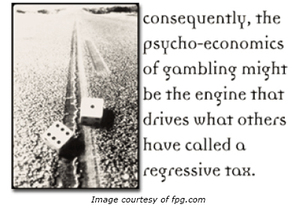Legalized gambling in Canada swelled during the 1990’s as government-owned gaming expanded throughout the decade (Korn, 2000). This expansion derived from a change in economic policy intended to increase national revenue without additional taxation, encourage economic growth in the entertainment and leisure sectors, and rouse greater support for charitable gaming (Campbell & Smith, 1998, in Korn, 2000). While the impact of this fresh economic strategy has yet to fully materialize (Korn, 2000), some of its social and policy implications are becoming more clear.
According to a recent Statistics Canada report (Marshall, 1998, 2000, in Korn, 2000), upper-income households spend more than lower-income households on lottery, casino, slot machine, and video lottery gambling[1]. Proportionately, however, gambling expenditures between upper- and lower-income households are reversed. Households earning less than $20,000 annually reportedly spend an average of $296 on gaming, or 2.2% of their annual income, whereas households earning $80,000 annually spend $536, or 0.5% of their total income[2] (Korn, 2000). According to Korn (2000), such expenditure differences can be interpreted “. . . as a voluntary regressive tax that has a proportionately greater impact on people with lower incomes” (Korn, 2000, p. 63).
More research is necessary to address whether lower-income households are actually contributing proportionately more money to the Canadian government than their upper-income counterparts. The psycho-economics of gambling would predict this pattern, however. Lopes (1987), for example, noted that people who have less will risk more since it holds the potential to change their lives. People of means, however, will not risk as much since even a big win will not impact their lives as much as those of lesser means (Lopes, 1987).
Despite this ubiquitous driving force, Korn (2000) suggests that some measures might assure that persons from all economic strata will not be subject to gambling exploitation. For instance, policy-makers should monitor government-owned and sponsored gambling operations to maintain a balance between encouraging public participation and protecting the public from gambling’s associated ills (Korn, 2000). Additionally, gambling advertising must be closely scrutinized by government officials to avoid publicly promoted falsities regarding the odds of winning and losing, especially among Canada’s youth and lower socio-economic groups (Korn, 2000). Furthermore, the impact of gambling’s expansion throughout Canada should be continually assessed, weighing health, economic, social, and environmental circumstances (Shookner, 1998, in Korn, 2000) among all individuals and population segments (Korn, 2000). Finally, strategies must be developed to appropriately identify, treat, and minimize the adverse health, economic, and social consequences that problem and pathological Canadian gamblers experience (Korn, 2000).
The social and policy implications of gambling’s expansion throughout Canada cannot be properly addressed through statistical reports and recommendations alone. Indeed, a broad research agenda from which policy should derive–not vise-versa–must be adopted that focuses on gambling-related concerns including neurobiological behavior, comorbid disorders, and effective treatment (i.e., medicinal and therapeutic) strategies (Korn, 2000). Without such an agenda, we risk homogeneously classifying gambling in Canada–and in other countries worldwide–as strictly a positive or negative action rather than dissecting it as a government-owned cultural activity that has both positive and negative implications.
[1] Bingo was the only gambling activity found inversely correlated with income.
[2] These data pertain to households within which at least one person was involved in gambling.
References
Campbell, C. S., & Smith, G. J. (1998). Canadian gambling: trends and public policy issues. In J. H. Frey (Ed.), Gambling: socioeconomic impacts and public policy. (pp. 22-35). Thousand Oaks: Sage Publications.
Korn, D. A. (2000). Expansion of gambling in Canada: implications for health and social policy. Canadian Medical Association Journal, 163(1), 61-64.
Lopes, L. (1987). Between hope and fear: the psychology of risk. In L. Berkowitz (Ed.), Advances in experimental and social psychology. (pp. 255-295). San Diego: Academic Press.
Marshall, K. (2000). Update on gambling. Perspectives on Labour and Income, 12(1), 29-35.
Marshall, K. (1998). The gambling industry: raising the stakes. Perspectives on Labour and Income, 10(4), 7-11.
Shookner, M. (1998). The quality of life in Ontario. Toronto: Ontario Social Development Council and Social Planning Network of Ontario.
The WAGER is a public education project of the Division on Addictions at Harvard Medical
School. It is funded, in part, by the National Center for Responsible Gaming, the
Massachusetts Department of Public Health, the Addiction Technology Transfer Center of
New England, the Substance Abuse and Mental Health Services Administration, and the
Center for Substance Abuse Treatment.





